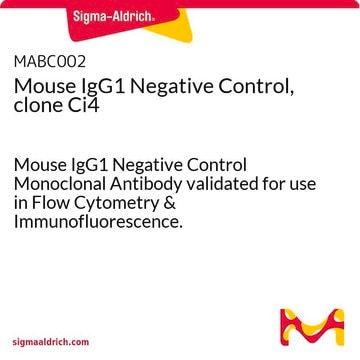推荐产品
生物来源
mouse
质量水平
抗体形式
purified from hybridoma cell culture
抗体产品类型
primary antibodies
克隆
8C/6-39, monoclonal
表单
buffered aqueous solution
种属反应性
human
浓度
~1 mg/mL
技术
indirect ELISA: 3-6 μg/mL using Human IgG1 myeloma protein for coating.
同位素/亚型
IgG2a
运输
dry ice
储存温度
−20°C
靶向翻译后修饰
unmodified
一般描述
Human IgGs consist of four subclasses (1-4) that can be recognized by antigenic differences in their heavy chains. They constitute approximately 65, 30, 5 and 4% of the total IgG, respectively. Each subclass has different biological and physiochemical properties. The IgG subclass may be preferentially produced in response to different antigens and pathological conditions. For instance, anti-polysaccharide responses are mainly of the IgG2 subclass while protein antigens give rise to IgG1 and IgG3 antibodies. Human IgG1 is the predominant subclass of in vivo and in vitro produced anti-tetanus toxoid antibodies. IgG1 and IgG3 are the only subclasses capable of adherence to mononuclear phagocytes and are recognized readily by the Fc receptors on various reticulo-endothelial cells while IgG2 and IgG4 are far less efficient. The amount of the different IgG subclasses present in the bloodstream varies with age. For example, IgG1 and IgG3 reach normal adult levels by 5-7 years of age while IgG2 and IgG4 levels raise more slowly, reaching adult levels at about 10 years of age. Serum IgG subclass deficiencies have been recorded for different patient groups. For example, a disproportionate elevation of IgG1 has been found in the cerebral spinal fluid of patients with multiple sclerosis. Examination of the distribution pattern of IgG subclasses in different types of diseases may provide insight into the immunological processes involved and thus may assist in the diagnosis of various disorders.
免疫原
The Fc fragment of a human IgG1 myeloma protein.
应用
Indirect ELISA: a working concentration of 3-6 μg/mL is recommended using 10 μg/mL Human IgG1 myeloma protein for coating.
外形
Solution in 0.01 M phosphate buffered saline, pH 7.4, containing 15mM sodium azide.
其他说明
In order to obtain best results in different techniques and preparations we recommend determining optimal working concentration by titration test.
未找到合适的产品?
试试我们的产品选型工具.
储存分类代码
10 - Combustible liquids
WGK
WGK 3
闪点(°F)
Not applicable
闪点(°C)
Not applicable
历史批次信息供参考:
分析证书(COA)
Lot/Batch Number
其他客户在看
我们的科学家团队拥有各种研究领域经验,包括生命科学、材料科学、化学合成、色谱、分析及许多其他领域.
联系客户支持












